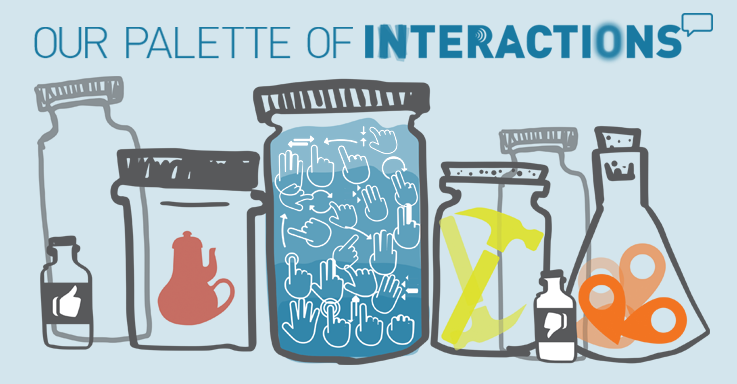About
Welcome designers, students, and interested public…
This design wiki invites you to deeply investigate the tools of interaction design at our disposal. By thinking critically about the atomic elements that designs may use and broadening our perception of what tools are available to us as we work on ever-changing design problems, technologies, and situations. You the public is asked to be critical co-creators of interaction design, considering not just what they are but what they do — what affect design has on its audience.
Example:
‘is’ vs ‘does’
You’ll notice a few sample posts created for your convenience. These entries have defined interaction design elements and began analyzing them to discover ways the develop meaning. We’re interested in going beyond what something is and evaluating what action it does—or how it affects people—in order to find ways elements could be used interchangeably to create the same effect.
Getting started:
Everyone is invited to participate no matter what level of experience they are at!




- Submit a new entry
Whatever moves you: Create a new entry defining an element (don’t worry, we’ll walk you through it!) or create a frameworks for analysis. It’s your chance to get your thoughts out and expand the definitions for everyone. Growing this design lexicon is important for the success of the website. - Register to this website and start editing posts (registration is in the upper right hand side of this website, it’s super fast!)
Maybe you’re really into good grammar, have a cool example to show, want to change change the taxonomy. Share your own definitions and interpretation of design elements. The power is yours. - Discuss, rate, or and comment on posts and pages
Your thoughtful insights help others. - Be hero!—Take this survey about your experience.
After you’ve contributed to the website, don’t forget the most important part: telling me about it!
EXAMPLE: if I was describing how the element of color may be used in interaction design:
- Information: Importance might be indicated by color in text. Putting a word might indicate required text in a form field.
- Feedback: A button may change colors to indicate different states like active, inactive, hover, pressed, and visited.
- Metaphorically: Color is often used as al literal metaphor like when red is used for something ‘hot’ like flames are. Or stages of an activity might be red-yellow-green to recreate a traffic lights. Or dull colors (browns and beiges) might be used to make something appear more formal or physical (like re-creating old paper) whereas vibrant, right colors might be used to show something digital or modern.
- Symbolically: Color may be symbolic based on cultural norms. For instance, red is often used to indicate warning, danger, or errors.
- Performative: Because of our symbolic associations with a color, we might interact differently with a device. For instance, we might feel more tentative about pushing a red button than a green button because we associate red with important or dangerous.
Thank you advance for your participation!
Have some questions or comments? Contact me at jacklynn / @ / cmu . edu

Recent Conversations